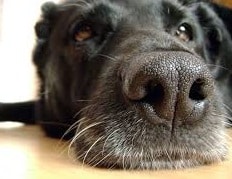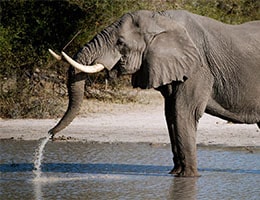 The prominent sector of the face of certain animals , in which the nose and mouth are located, is called the snout . The snouts are very diverse according to the species in question.
The prominent sector of the face of certain animals , in which the nose and mouth are located, is called the snout . The snouts are very diverse according to the species in question.
Dogs are among the many animals that have snouts. In the Afghan hound , for example, the snout is elongated, while in the bulldog the snout is very short.
Some dog breeds are considered "dangerous" because it is believed that they tend to bite or that their bites can cause considerable damage, including death. In such cases, it is common for a muzzle to be placed on their snout. This device (which is usually made of leather, metal or plastic, among other materials) is adjusted so that the individual cannot open their mouth , and many models cause breathing problems.
Pack animals also often have a muzzle placed on their snouts. In this case, the objective is for you not to stop to eat and thus continue your journey without interruptions.
The muzzle, on the other hand, can be worn on the muzzle of racehorses as part of the bridle (a frame of straps). The utensil, in this context, is used to tie the horse to the manger or another place.
Another type of snout is the proboscis , the mouthpart that is shaped like a beak or proboscis . The elephant's trunk, in fact, is considered the longest snout in the animal kingdom.
Hocico , finally, is the name of a Mexican electro-industrial music group. Founded by Erk Aicrag and Racso Agroyam in 1993 , the band released more than a dozen albums and has performed alongside artists such as Marilyn Manson and Rammstein .
At first glance, the snout is one of the features that most distinguishes humans from other mammals. Far from being a different arrangement of the nose and mouth, or a protuberance on the face, this part of the animal body hides another series of differences that make them fascinating.
 Returning to the case of dogs, it is known that they have a sense of smell much superior to ours. In fact, to make a crude comparison, we can rely on the number of olfactory receptors that each species has: they can have three hundred million, while we only have five; Still, dogs can be up to a million times more sensitive to certain smells than we are. Outside of these numbers, the secret of its developed perception is found in the morphology of the snout.
Returning to the case of dogs, it is known that they have a sense of smell much superior to ours. In fact, to make a crude comparison, we can rely on the number of olfactory receptors that each species has: they can have three hundred million, while we only have five; Still, dogs can be up to a million times more sensitive to certain smells than we are. Outside of these numbers, the secret of its developed perception is found in the morphology of the snout.
Nor should we forget about dogs' mouths, which have a bite power considerably greater than ours. This is because wolves, the species from which they descend, are primarily carnivorous animals and therefore must hunt for food. Thanks to the length and slightly pointed shape of their snout, they can crush their prey, tear their skin and insert their mouth when they need to.
Another characteristic of the snout is related to breathing and the regulation of body temperature in dogs. Most popular breeds tend to open their mouths very frequently, especially in hot weather; The reason is as simple as it is sophisticated, since by breathing through the mouth they manage to reduce their temperature at a much greater rate than through the nose.
This need, which some dogs have more pronounced than others, is one of the reasons why we should never subject them to the use of a muzzle. The solution to avoid breaking the law is to stop supporting the breeding of dogs considered dangerous.
